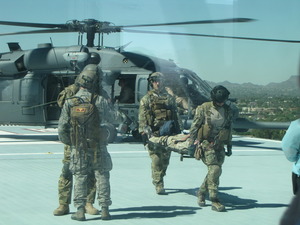Called “Guardian Angels,” the U.S. military’s search and rescue specialists, para-rescue specialists and search, evasion, resistance, and escape (SERE) specialists, are some of the toughest troopers the military has. Little known outside the personnel recovery (PR) community, they undergo training that is every bit as demanding as that of Special Forces, Army Rangers, or Navy SEALS. In fact, they’re often the guys who have to go in and rescue these elite forces when they’re stranded behind enemy lines.
In addition to their role of rescuing stranded soldiers or downed pilots, though, they’re often called upon to assist in humanitarian emergencies to rescue stranded civilians in isolated or difficult to access areas, as part of the U.S. Government’s ‘whole-of-government’ personnel recovery policy.
In the fall of 2011, I was invited by the U.S. Air Force to participate in its annual exercise to test its ability to conduct rescue operations under any and all conditions. Called ANGEL THUNDER, this exercise in Arizona and New Mexico, involves units of the Air Force, the U.S. Army, civilian agencies like the Department of State, US Agency for International Development (USAID), the Drug Enforcement Administration (DEA), and rescue forces of other nations. In 2011, there were participants from Sweden, Singapore, Canada, and Colombia. In addition, the University of Arizona Medical Center and fire and police officials of Pima County, Arizona participated.
I had a great role in the exercise; I was a civilian stranded in a mountainous area, and the Guardian Angels in their HH-60 had to fly in, retrieve me, and get me to medical care. The experience is one that I am unlikely to ever forget. When that big chopper swooped in from over the ridge line, even though I knew it was just an exercise, I could feel my heart racing. I’d been made up to simulate internal injuries, and briefed on how to act for realism. It quickly no longer seemed like an exercise when the PJs (or para-jumpers the name given to para-rescue men) swarmed out of the helicopter and secured the area. One thing I forgot to mention; these guys go into some pretty dicey areas, so they’re armed to the teeth along with their emergency medical equipment.
The PJ in charge immediately checked me over, asking questions similar to what a doctor would want to know, and administered necessary emergency medical treatment to ‘stabilize’ me. I was then strapped into a folding plastic ‘stretcher’ and carried down the slope to the waiting helicopter. The PJ stayed with me throughout the flight, making sure my vital signs were stable. After a one-hour flight, I was transferred to a C-130 Hercules flown by a Canadian crew for onward transport to a hospital. The Canadians were every bit as professional, though a bit less militant looking, as the U.S. Air Force guys, and even had a female flight surgeon as part of the crew. Taking off from a small landing strip somewhere in the northern part of Arizona, they flew me to Davis-Monthan Air Force Base, where a Pima County Fire Department ambulance then transported me to a tent medical facility where further medical treatment was administered.
Some of the ‘patients’ in the exercise were flown to the rooftop helipad of the University of Arizona Medical Center where they were looked after by hospital personnel right along with their real patients.
Anyone who thinks the military doesn’t work well with civilians needs to observe ANGEL THUNDER to know that this is just an urban legend. When the chips are down, these professionals forget uniforms, ranks, and all the other bureaucratic bull, and just get the job done.
(Note to editor) Photos (C) by Charles Ray
1. Air Force para-rescue specialists move a ‘patient’ from an HH-60 that has landed on the helipad at the University of Arizona Medical Center.
2. University of Arizona Medical Center personnel treat a ‘patient’ who was rescued by the Air Force.
3. A Swedish search dog team assists in locating lost or isolated people in a simulated natural disaster in Exercise ANGEL THUNDER.


